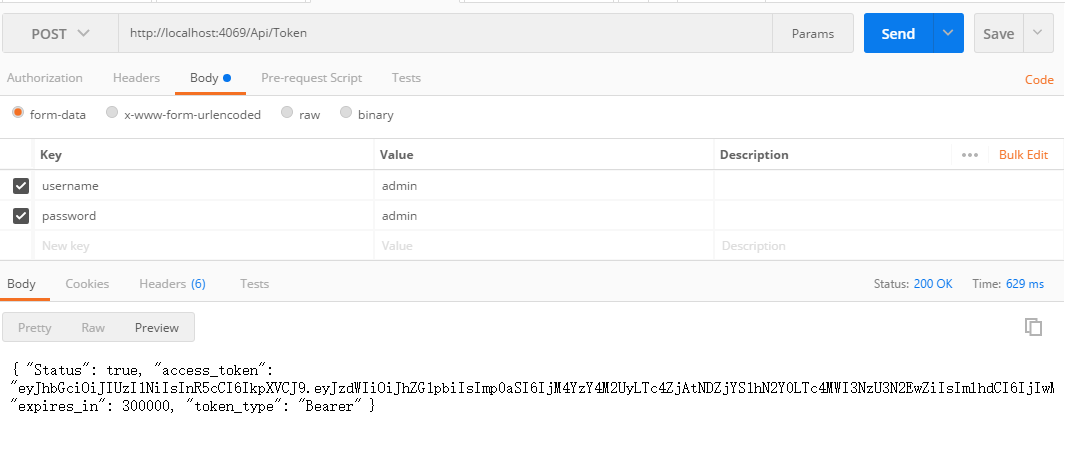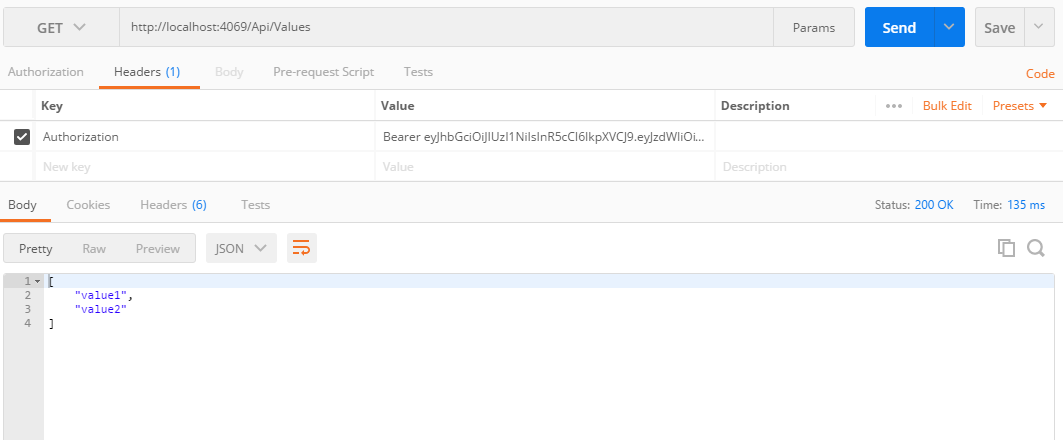经历了很久,.net core 2.0 终于发布了!
之前一直用的core 1.1,升级了2.0后发现认证的机制(Auth)发生了比较大的变化,在1.1中认证配置是在Configure中完成,而在2.0中,认证配置则是在ConfigureServices中完成,刚好对调了一下。
话不多说,直接看代码
1.ConfigureServices中的认证配置
var audienceConfig = Configuration.GetSection("Audience"); var symmetricKeyAsBase64 = audienceConfig["Secret"]; var keyByteArray = Encoding.ASCII.GetBytes(symmetricKeyAsBase64); var signingKey = new SymmetricSecurityKey(keyByteArray); var tokenValidationParameters = new TokenValidationParameters { // The signing key must match! ValidateIssuerSigningKey = true, IssuerSigningKey = signingKey, // Validate the JWT Issuer (iss) claim ValidateIssuer = true, ValidIssuer = audienceConfig["Issuer"], // Validate the JWT Audience (aud) claim ValidateAudience = true, ValidAudience = audienceConfig["Audience"], // Validate the token expiry ValidateLifetime = true, ClockSkew = TimeSpan.Zero }; services.AddAuthentication(options => { options.DefaultAuthenticateScheme = JwtBearerDefaults.AuthenticationScheme; options.DefaultChallengeScheme = JwtBearerDefaults.AuthenticationScheme; }) .AddJwtBearer(o => { //不使用https //o.RequireHttpsMetadata = false; o.TokenValidationParameters = tokenValidationParameters; });
贴上appsettings.json的内容
"Audience": { "Secret": "Y2F0Y2yhciUyMHdvbmclMFWfsaZlJTIwLm5ldA==", "Issuer": "test", "Audience": "test" }
2. Configure中使用认证,这里我重载了UseAuthentication的方法。
(1)先定义一个TokenProviderOptions类
public class TokenProviderOptions { /// <summary> /// 请求路径 /// </summary> public string Path { get; set; } = "/Api/Token"; public string Issuer { get; set; } public string Audience { get; set; } /// <summary> /// 过期时间 /// </summary> public TimeSpan Expiration { get; set; } = TimeSpan.FromMinutes(5000); public SigningCredentials SigningCredentials { get; set; } }
(2)定义一个TokenProviderExtensions类重载UseAuthentication方法
public static class TokenProviderExtensions { public static IApplicationBuilder UseAuthentication(this IApplicationBuilder app, TokenProviderOptions options) { if (app == null) { throw new ArgumentNullException(nameof(app)); } return app.UseMiddleware<TokenProviderMiddleware>(Options.Create(options)); } }
至于为什么UseAuthentication为什么长这样的,可以看https://github.com/aspnet/Security/blob/99aa3bd35dd5fbe46a93eef8a2c8ab1f9fe8d05b/src/Microsoft.AspNetCore.Authentication/AuthAppBuilderExtensions.cs源代码
(3)写了AuthenticationMiddleware类来代替AuthenticationMiddleware
public class TokenProviderMiddleware { private readonly RequestDelegate _next; private readonly TokenProviderOptions _options; private readonly IUserService _service; public TokenProviderMiddleware( RequestDelegate next, IOptions<TokenProviderOptions> options, IUserService _service, IAuthenticationSchemeProvider schemes) { _next = next; _options = options.Value; this._service = _service; Schemes = schemes; } public IAuthenticationSchemeProvider Schemes { get; set; } /// <summary> /// invoke the middleware /// </summary> /// <param name="context"></param> /// <returns></returns> public async Task Invoke(HttpContext context) { // context.Features.Set<IAuthenticationFeature>(new AuthenticationFeature { OriginalPath = context.Request.Path, OriginalPathBase = context.Request.PathBase }); //获取默认Scheme(或者AuthorizeAttribute指定的Scheme)的AuthenticationHandler var handlers = context.RequestServices.GetRequiredService<IAuthenticationHandlerProvider>(); foreach (var scheme in await Schemes.GetRequestHandlerSchemesAsync()) { var handler = await handlers.GetHandlerAsync(context, scheme.Name) as IAuthenticationRequestHandler; if (handler != null && await handler.HandleRequestAsync()) { return; } } var defaultAuthenticate = await Schemes.GetDefaultAuthenticateSchemeAsync(); if (defaultAuthenticate != null) { var result = await context.AuthenticateAsync(defaultAuthenticate.Name); if (result?.Principal != null) { context.User = result.Principal; } } // if (!context.Request.Path.Equals(_options.Path, StringComparison.Ordinal)) { await _next(context); return; } // Request must be POST with Content-Type: application/x-www-form-urlencoded if (!context.Request.Method.Equals("POST") || !context.Request.HasFormContentType) { await ReturnBadRequest(context); return; } await GenerateAuthorizedResult(context); } /// <summary> /// 验证结果并得到token /// </summary> /// <param name="context"></param> /// <returns></returns> private async Task GenerateAuthorizedResult(HttpContext context) { var username = context.Request.Form["username"]; var password = context.Request.Form["password"]; var identity = await GetIdentity(username, password); if (identity == null) { await ReturnBadRequest(context); return; } // Serialize and return the response context.Response.ContentType = "application/json"; await context.Response.WriteAsync(GetJwt(username)); } /// <summary> /// 验证用户 /// </summary> /// <param name="username"></param> /// <param name="password"></param> /// <returns></returns> private Task<ClaimsIdentity> GetIdentity(string username, string password) { var isValidated = _service.Auth(username,password); if (isValidated) { return Task.FromResult(new ClaimsIdentity(new System.Security.Principal.GenericIdentity(username, "Token"), new Claim[] { })); } return Task.FromResult<ClaimsIdentity>(null); } /// <summary> /// return the bad request (200) /// </summary> /// <param name="context"></param> /// <returns></returns> private async Task ReturnBadRequest(HttpContext context) { context.Response.StatusCode = 200; await context.Response.WriteAsync(JsonConvert.SerializeObject(new { Status = false, Message = "认证失败" })); } /// <summary> /// get the jwt /// </summary> /// <param name="username"></param> /// <returns></returns> private string GetJwt(string username) { var now = DateTime.UtcNow; var claims = new Claim[] { new Claim(JwtRegisteredClaimNames.Sub, username), new Claim(JwtRegisteredClaimNames.Jti, Guid.NewGuid().ToString()), new Claim(JwtRegisteredClaimNames.Iat, now.ToUniversalTime().ToString(), ClaimValueTypes.Integer64), //用户名 new Claim(ClaimTypes.Name,username), //角色 new Claim(ClaimTypes.Role,"a") }; var jwt = new JwtSecurityToken( issuer: _options.Issuer, audience: _options.Audience, claims: claims, notBefore: now, expires: now.Add(_options.Expiration), signingCredentials:_options.SigningCredentials ); var encodedJwt = new JwtSecurityTokenHandler().WriteToken(jwt); var response = new { Status=true, access_token = encodedJwt, expires_in = (int)_options.Expiration.TotalSeconds, token_type = "Bearer" }; return JsonConvert.SerializeObject(response, new JsonSerializerSettings { Formatting = Formatting.Indented }); } }
(4)最后Configure中使用认证
var audienceConfig = Configuration.GetSection("Audience"); var symmetricKeyAsBase64 = audienceConfig["Secret"]; var keyByteArray = Encoding.ASCII.GetBytes(symmetricKeyAsBase64); var signingKey = new SymmetricSecurityKey(keyByteArray); var SigningCredentials = new SigningCredentials(signingKey, SecurityAlgorithms.HmacSha256); app.UseAuthentication(new TokenProviderOptions { Audience = audienceConfig["Audience"], Issuer = audienceConfig["Issuer"], SigningCredentials = new SigningCredentials(signingKey, SecurityAlgorithms.HmacSha256) });
3.最后的测试

